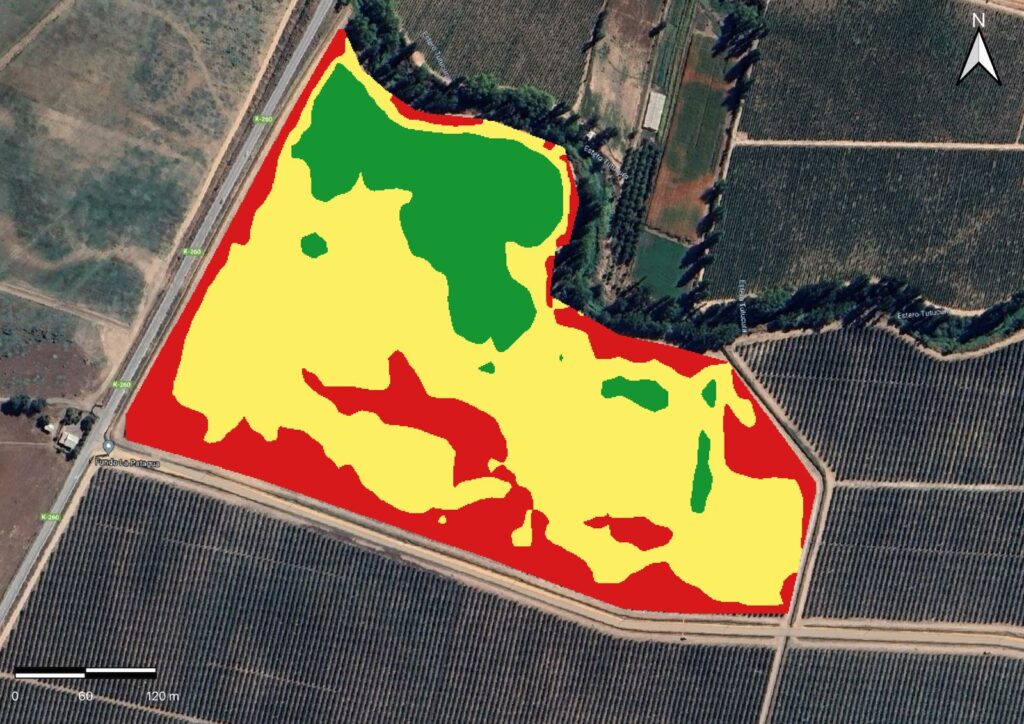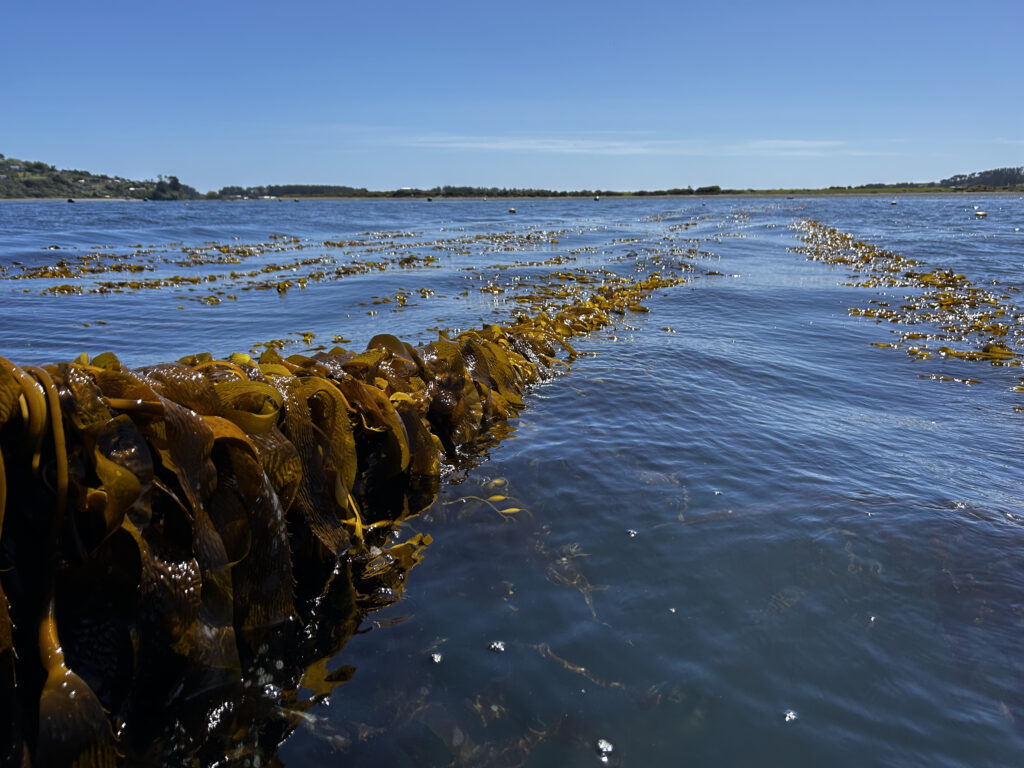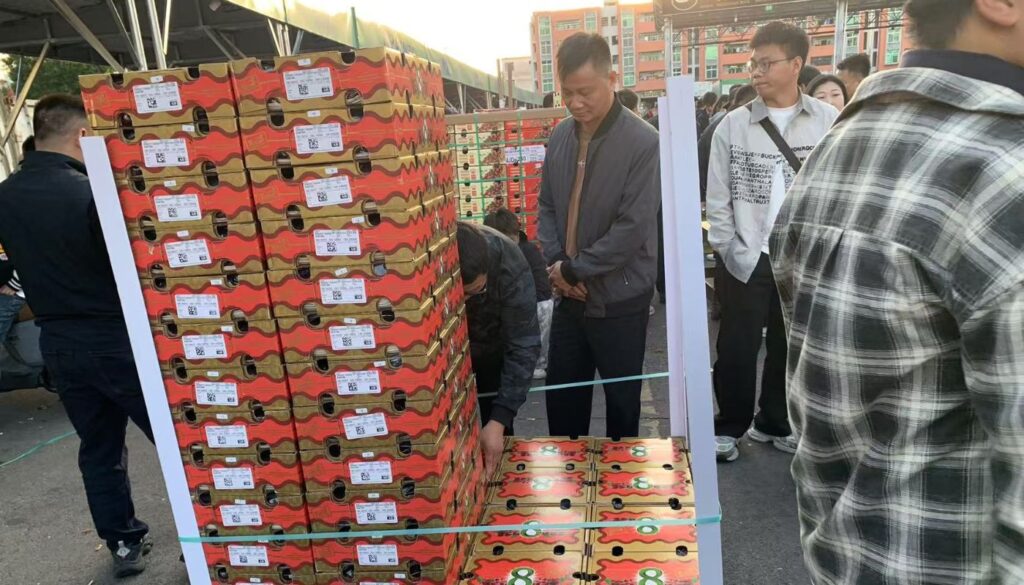The best time to apply gibberellic acid is at stage 3 of cell elongation; the beginning of this stage can be recognized by the color change from green to yellow, commonly known as straw color, which in practice coincides with the beginning of veraison.
The size is undoubtedly one of the most relevant attributes in the production of cherries; quality and size are fundamental when it comes to exporting, since the financial returns that producers and exporters will receive depend on them, along with other factors. Every season, and despite the different conditions that may arise, there is a challenge that does not vary and that is, precisely, to produce this attractive fruit, of quality, good size, firm, without cracks, with long and hydrated pedicels, etc.
The sustained increase in cherry production, which during the 2021-22 season ended with more than 356 thousand tons of this fruit exported, and which this year estimates a growth of 25 percent, has given even more relevance to quality and the maintenance of this attribute throughout the supply chain. However, with the adoption of early rootstocks that control vegetative expression, there is a tendency for the leaf/fruit ratio to be lower, which causes yields above the maximum productive potential, thus sometimes obtaining poor quality fruits (Whiting and Lang 2004; Whiting et al. 2005).
There are a number of agronomic management measures that can be carried out, including nutritional programs, adequate irrigation or thinning to improve the source-sink balance and the quality of the fruit. However, carrying out this management is becoming increasingly complex due to the shortage of labor. This is where the option of manipulating the source-sink activity with exogenous regulators of plant growth through phytohormones arises.
These phytohormones are conventionally classified into nine classes: auxins, abscisic acid, cytokinins, gibberellins, ethylene, brassinosteroids, jasmonates, salicylic acid and strigolactones (considered a plant hormone since 2012). On this occasion, we will address the use of gibberellic acid (GA) in cherry production, time of application, dose, effects, etc.
Gibberellins were discovered in studies on the fungus ascomycete Gibberella fujikuroi in rice plants; most of these are acidic and are indicated as GA (gibberellic acid), followed by a number corresponding to the order in which it was discovered. GA1, GA3, GA4, GA5, GA6 and GA7 are the most active forms, and the rest are their precursors.
Gibberellic acid has been widely discussed and its main characteristics have been established: it participates in fruit development, cell elongation, internode lengthening, promotes flowering in annual plants, inhibits flowering in perennial plants and promotes germination. There are currently countless GAs associated with agriculture, probably 100 of them, however the one that is usually used in cherry production is GA3, which is used for different objectives in terms of development, both of shoots and to enhance fruit elongation in the final stage, both in self-fertile and cross-pollinated varieties.
How does gibberellic acid act to increase the size of fruits? This product works via the cell by stimulating the proton pumps located in the cell wall; the stimulation generates an acidification of the cell wall by activating enzymes called expansins, which break/cut the existing bonds between the cellulose molecules, causing the cell walls to be more elastic. Then, it is the entry of water that allows the elongation of the cells causing a subsequent increase in size.
Fruit growth will depend on the accumulation of dry matter and water and will be determined, and may be limited, by its source-sink capacity and the availability of metabolites in the plant. The sink capacity of the fruit is considered the dominant factor in the competition for photoassimilates and is initially determined by the quality of the flower and the number of flowers formed on the tree (Guardiola, 1997).
The Avium research and development team, together with cherry producers in Chile, have carried out a series of trials in this regard, through which the great effect of using GA3 as a complement to the nutritional program in cherry trees has been demonstrated, on soluble solids, dry matter and hardness (Durofel) and, above all, regarding fruit size, where each of these parameters have been directly and positively influenced by exogenous applications of GA3. (Tapia, C. 2015).
In turn, the effect of complementary applications of GA3 has been shown to have a clear positive impact on the average size and weight of the fruit, as well as a clear shift in the size curve towards the most commercially attractive sizes.
When and how much to apply?
It is established that the time of application of gibberellic acid is in stage 3 of cell elongation; the beginning of this stage can be recognized with the change of color of the fruit from green to yellow, which is commonly known as straw color. However, in practice it is very complex to identify this phenological state, therefore, in order to avoid confusion and to apply GA3 at the most opportune moment, it is recommended to do so at the beginning of veraison. This considering that the best moment of each phenological state is the beginning of the following phenological state, thus the best moment of white buds are the first open flowers, the best moment of full flower is the beginning of petal fall and the best moment of straw color is the beginning of veraison.
To recognize the beginning of veraison, in addition to detecting the change in color of the fruit from green to yellow, it is possible to determine it when 5-10 percent of the fruit has begun to take on a pinkish color, beginning of red; at that time, probably, a large percentage of the fruit on the plant is above the color break and the optimal conditions for the application of GA3 are given.
The use of exogenous GA3 in the third stage of fruit growth is directly related to the final size of the fruit. However, it should be noted that it is often mistaken to think that GA3 also feeds firmness. Gibberellic acid, in addition to contributing to cell elongation and fruit size, improves HARDNESS, since firmness can be directly associated with the dry matter of the fruit and at the time when GA3 is applied it has very little to contribute to the increase in dry matter, since this is mainly developed in the cell division phase, in stage one of fruit growth, perhaps up to 30 days after full flower.
Now, regarding the concentration of applications, the Avium technical team has studied that there is a direct relationship between the use or concentration of GA3 and the size of fruits, but beyond 40 ppm there is no direct increase in size, therefore using more than 40 or 45 ppm, in general there is no greater effect in terms of cell elongation and final size.
The variation in said concentration is subject to various factors that are explained below:
Orchard load status: General considerations.
a)Balanced charge states: it is recommended to use a medium concentration of GA3, i.e. between 20-30 ppm.
b) Light load states, under 6 thousand – 5 thousand kilos per hectare: use concentrations around 10 ppm.
c) High load states, over 15 thousand kilos: approach concentrations of 40 ppm.
Cultivars most sensitive to splitting:
This aspect is a factor in making the decision regarding the correct concentration; cultivars that are more sensitive to cracking clearly need to be cautious when using GA3 and not exceed 20-25 ppm, since this is an area that is more sensitive to some type of cracking, generally not caused by rain, but by free water, dense fog, drizzle, and often condensation in the most humid areas.
There are undoubtedly many benefits to applying this type of phytohormones, but it should be mentioned that it causes a certain amount of disruption in the colouring of the fruit; it is not a question of “delays in colouring”, therefore, in earlier varieties, considering that the objective is to harvest before 20-25 November, it is not recommended to overuse GA3; in these cases, it is recommended to reach a concentration of 20-25 ppm, always considering that it will be done in a single application and at the best time.
Considering that in our country there are many alternatives of AG3 in commercial products, with differences in concentration, formulation and format, Avium has designed a table with these relationships according to need.
Table: Relationships between concentration (ppm) of active ingredient AG3 and concentration (g or cc/100 L) of commercial product present in Chile.
Is it recommended to use gibberellic acid in all cases? The answer is yes, because there is always a positive effect from this application; in orchards of 2,000 to 3,000 kilos per hectare, to the extent that the methodology of application to all the fruits can be achieved, since it works by contact, the minimum concentration to use is 10 ppm.
Furthermore, exogenous application of phytohormones may be useful to return metabolic activities to normal levels. GA3, at a certain concentration, has been shown to be beneficial for the physiology and metabolism of many plants subjected to abiotic stress, as it can regulate the metabolic process based on antioxidant and sugar signaling enzymes.
Regarding the adverse effects of using gibberellic acid, it is possible to point out that, after various studies carried out during the last seasons by Avium, when concentrations higher than 30-35 ppm are used (when justified), deterioration of the pedicel is generated, which dehydrates more easily. In these cases, it is recommended to accompany the application of GA3 with some type of plant extract, for example from algae, which allows to soften this powerful effect that gibberellic acid has on the elongation of cells in the pedicel tissue that, apparently, are more delicate than those of the fruit. In this way, these cells are prevented from breaking and subsequently dehydrating, therefore applications of GA3 that are going to exceed 25-30 ppm, should always be accompanied by some type of plant extract.
It is essential to establish specific concentrations for each situation, in addition to ensuring that the application methodologies are perfect and that the application reaches all points of the plant and 100 percent of the fruit so that it is directly related to the main objective, which is to improve the size of the fruit.
As a practical tip, do not get nervous when the fruit starts to turn from green to yellow; it is always better to wait to see the first pink fruits and then apply the best concentration depending on the main objective in each case.








